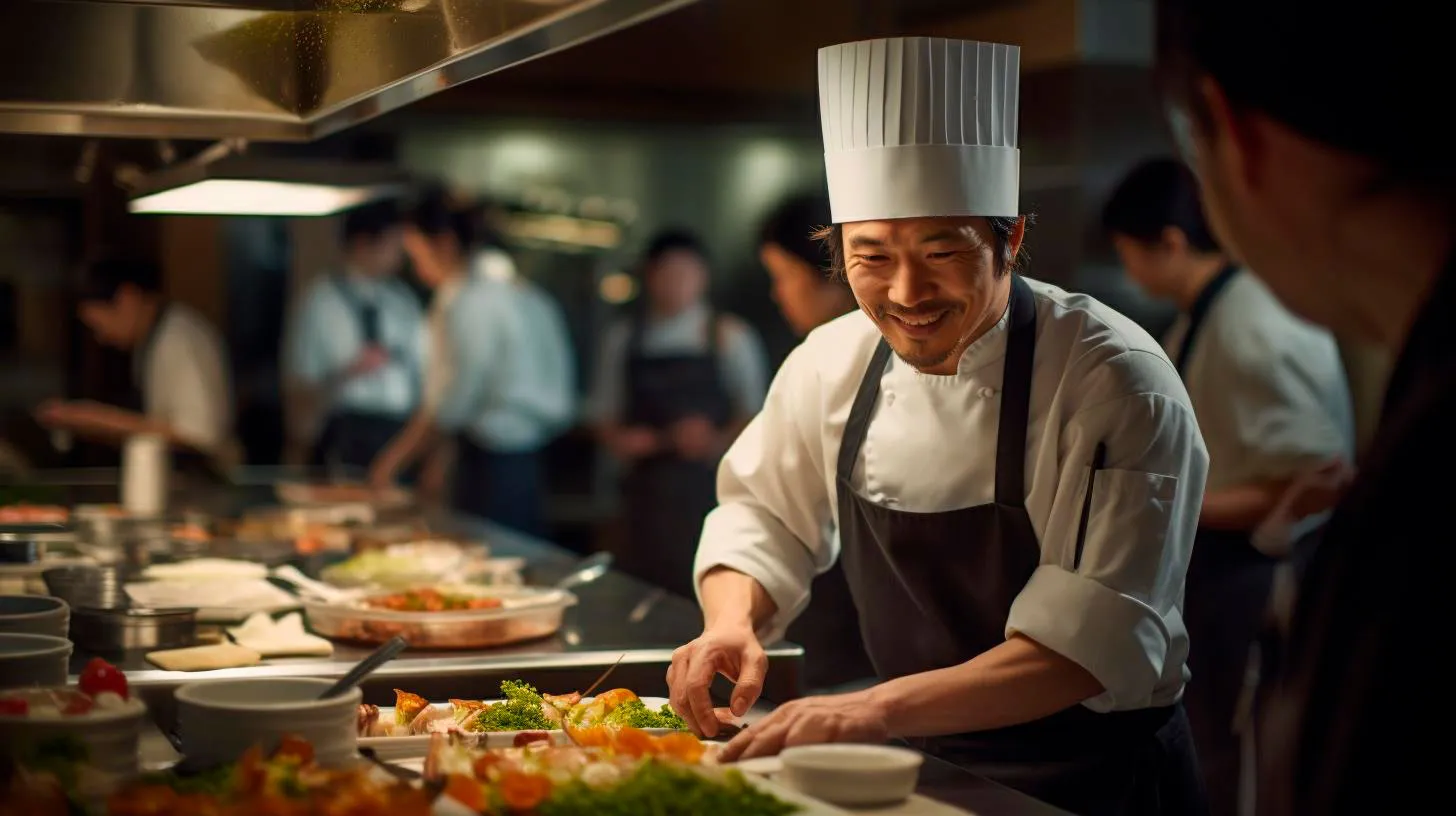Unveiling the Intricate Flavors of Japanese Cuisine
Get ready for a journey through the fascinating world of Japanese gastronomy!
The Essence of Japanese Cuisine
Japanese cuisine is deeply rooted in the country’s culture and emphasizes the balance of flavors, textures, and colors. The emphasis on simplicity, seasonality, and the use of locally sourced ingredients sets it apart from other global culinary styles. Here are some key features that define the essence of Japanese cuisine:
- Umami: Japanese cuisine is famous for its umami flavor, often referred to as the “fifth taste.” Umami is a savory taste that adds depth and complexity to dishes. It is achieved through the use of ingredients like miso, soy sauce, bonito flakes, and seaweed.
- Minimalism: Japanese cuisine emphasizes simplicity and minimalism. Rather than overpowering dishes with numerous ingredients, Japanese chefs focus on enhancing the natural flavors of each component. This approach allows the true essence of the ingredients to shine.
- Presentation: Japanese cuisine places great importance on food presentation. Dishes are meticulously arranged, creating visual works of art. The use of vibrant colors and careful placement of ingredients adds to the overall dining experience.
- Seasonality: With a strong connection to nature, Japanese cuisine celebrates seasonal ingredients. Chefs prioritize using fresh produce that is in season to ensure the highest quality and authentic flavors in their creations.
The Key Ingredients
To truly appreciate Japanese cuisine, it is essential to familiarize yourself with the key ingredients that add depth and complexity to dishes. Here are some of the most important ingredients in Japanese cooking:
- Rice: Rice is a staple of Japanese cuisine and is used in a variety of dishes, including sushi, onigiri, and donburi. The quality and type of rice greatly impact the flavor and texture of these dishes.
- Soy Sauce: Soy sauce, or shoyu, is a crucial ingredient in Japanese cuisine. It is made from fermented soybeans, wheat, water, and salt. Soy sauce adds a rich, savory flavor to dishes and is used as a seasoning and condiment.
- Miso: Miso is a traditional Japanese seasoning made from fermented soybeans, rice, or barley. It is used in soups, marinades, glazes, and dressings, providing a unique umami flavor.
- Seaweed: Seaweed, such as nori and kombu, is used extensively in Japanese cuisine. It adds a subtle saltiness and umami flavor to dishes and is commonly found in sushi rolls, miso soup, and salads.
The Art of Japanese Cooking
Japanese cooking techniques are meticulously crafted to preserve the natural flavors and textures of ingredients while enhancing their taste. Here are some notable cooking techniques utilized in Japanese cuisine:
- Sushi: Sushi is a quintessential Japanese dish that showcases the skill and precision of sushi chefs. It involves combining vinegared rice with various ingredients, including raw or cooked fish, vegetables, and seafood, to create flavorful bite-sized pieces.
- Tempura: Tempura is a popular Japanese dish consisting of lightly battered and deep-fried seafood, vegetables, and mushrooms. The batter is light and crispy, allowing the delicate flavors of the ingredients to shine through.
- Teppanyaki: Teppanyaki is a style of cooking where ingredients, such as meat, seafood, and vegetables, are grilled on an iron griddle. The cooking process is often accompanied by an entertaining performance by the chef, adding to the overall dining experience.
- Sukiyaki: Sukiyaki is a comforting one-pot dish where thinly sliced beef is cooked with vegetables, tofu, and noodles in a sweet and savory soy-based sauce. The ingredients are slowly simmered, allowing them to absorb the flavors of the broth.
Key Takeaways
The world of Japanese cuisine is a harmonious blend of flavors, traditions, and aesthetics. By exploring its intricate nuances, we gain a deeper appreciation for the culinary artistry that has captivated taste buds for centuries. Here are some key takeaways:
- Japanese cuisine emphasizes simplicity, seasonality, and balance of flavors.
- Umami, the fifth taste, plays a significant role in Japanese dishes.
- Key ingredients such as rice, soy sauce, miso, and seaweed contribute to the unique flavors of Japanese cuisine.
- Cooking techniques like sushi-making, tempura frying, teppanyaki grilling, and sukiyaki simmering showcase the skill and precision of Japanese chefs.
- Enjoying Japanese cuisine is an immersive experience that combines visual aesthetics with exceptional taste.
As you embark on your culinary journey through Japanese cuisine, keep these insights in mind to fully appreciate the artistry and unique flavors that this amazing gastronomic tradition has to offer.
Capturing the Essence of Sushi
In this blog post, we will explore the essence of sushi, its history, types, and the art of enjoying this culinary masterpiece.
The History of Sushi
Although sushi is commonly associated with Japan, its origins can be traced back to Southeast Asia. In the 2nd century AD, people in Southeast Asia began preserving fish by fermenting it with rice. This preservation technique gradually made its way to Japan. Over time, the Japanese modified the process by using vinegar instead of fermentation to create the sushi we know today.
It wasn’t until the 19th century that sushi became widely popular in Japan. With the introduction of refrigeration techniques and the development of sushi rice, sushi gained a broader appeal. It quickly evolved from a street food to a culinary delicacy, appreciated by locals and foreigners alike.
Types of Sushi
Sushi comes in various forms, each with its unique taste and presentation. Here are some of the most popular types:
- Nigiri: Nigiri sushi consists of a small mound of sushi rice topped with a slice of raw fish or seafood. It is often served with a dab of wasabi and a brush of soy sauce.
- Maki: Maki sushi, also known as sushi rolls, is made by wrapping sushi rice and various fillings in a sheet of seaweed called nori. It is then sliced into bite-sized pieces.
- Sashimi: Sashimi is thinly sliced raw fish or seafood served without rice. It is usually accompanied by soy sauce and wasabi.
- Temaki: Temaki sushi is a hand-rolled cone-shaped sushi. It consists of sushi rice, fillings, and nori, wrapped into a convenient-to-eat cone.
The Art of Enjoying Sushi
While many simply enjoy the delightful taste of sushi, there is an art to savoring this culinary creation. Here are some tips to enhance your sushi experience:
- Start with lighter flavors: Begin your sushi feast with lighter-flavored options like white fish or vegetable rolls to appreciate the subtlety of flavors.
- Use chopsticks: Unless it’s a hand roll, sushi is best enjoyed with chopsticks. It adds a traditional touch and prevents the rice from falling apart.
- Dip, don’t soak: When dipping nigiri or maki into soy sauce, remember to dip only the fish side, not the rice. Soaking the rice can overpower the delicate taste.
- Experiment with wasabi: Wasabi, a spicy Japanese horseradish, enhances the flavor of sushi. Feel free to adjust the amount based on your preference, but remember not to overdo it.
- Enjoy ginger as a palate cleanser: Pickled ginger, or “gari,” is served alongside sushi to cleanse the palate between different types of sushi. It prepares your taste buds for the next flavor.
The Health Benefits of Sushi
Sushi not only tantalizes your taste buds but also offers several health benefits:
- Rich in omega-3 fatty acids: The fish used in sushi, such as salmon and tuna, are excellent sources of omega-3 fatty acids that promote heart health and reduce inflammation.
- Low in calories: Sushi, especially sashimi, is relatively low in calories compared to many other types of cuisine. It can be a good choice for those watching their calorie intake.
- Contains essential nutrients: Sushi is packed with essential nutrients like vitamins, minerals, and antioxidants, depending on the ingredients used.
The Future of Sushi
With its global popularity continuing to rise, the future of sushi looks promising. Here are a few trends shaping the sushi industry:
- Sustainable sourcing: As consumers become more conscious of environmental issues, there is a growing demand for sustainably sourced fish and seafood for sushi.
- Plant-based sushi: With the rise of vegetarian and vegan diets, chefs are experimenting with plant-based alternatives to traditional fish sushi.
- Technological advancements: Technology is making its mark on the sushi industry, with innovations like sushi-making robots and automated ordering systems.
So next time you indulge in sushi, take a moment to appreciate its colorful history, artistry, and health benefits. Whether you’re a sushi connoisseur or a first-time enthusiast, capturing the essence of sushi is an experience that transcends borders and cultures.
Captivate your taste buds with the delicate flavors of sushi, exploring the history, types, and art of enjoying this culinary masterpiece. Uncover the health benefits and discover the exciting trends shaping the future of sushi.
Showcasing Authenticity in Food Competitions
In this blog post, we will delve into the importance of authenticity in food competitions and how it adds value to the overall experience.
The Significance of Authenticity
Authenticity is a fundamental aspect of any food competition as it allows participants to celebrate the unique flavors, traditions, and cultures behind a specific dish. By emphasizing this element, such events provide a platform for talented chefs to showcase their skills while paying homage to the roots of the cuisine they are working with.
Here are some key reasons why authenticity is crucial in food competitions:
- Preserving Culinary Heritage: Authenticity ensures that traditional recipes and cooking techniques are honored, preventing them from being diluted or lost over time.
- Cultural Appreciation: Food competitions that highlight authenticity encourage participants and attendees to appreciate the cultural significance of various cuisines, fostering respect and understanding.
- Enhancing Consumer Experience: By promoting authenticity, food competitions offer a unique experience for consumers, allowing them to explore and savor genuine flavors.
- Encouraging Innovation: Authenticity acts as a catalyst for chefs to innovate within the boundaries of tradition, resulting in the creation of captivating fusion dishes that honor heritage while appealing to modern palates.
The Impact of Authenticity in Food Competitions
An emphasis on authenticity in food competitions creates a ripple effect, influencing various stakeholders involved. Let’s take a closer look at the impact:
For Chefs:
- Authenticity allows chefs to showcase their prowess in handling traditional ingredients and cooking methods.
- It encourages research and exploration, deepening their understanding of the cuisine they are working with.
- Chefs gain recognition for their ability to maintain the true essence of a dish while presenting it with their personal touch.
For Competitions:
- By promoting authenticity, culinary competitions attract more participants and increase their credibility.
- Authenticity adds excitement and depth to the contest, making it more compelling for viewers.
- Food competitions that focus on authenticity create a platform for cultural exchange while supporting local culinary traditions.
For Consumers:
- Authenticity guarantees that consumers can experience the rich flavors and textures associated with a particular cuisine.
- It allows food enthusiasts to expand their culinary horizons and learn about different cultures through their taste buds.
- Consumers develop trust in food competitions that prioritize authenticity, leading to increased participation and attendance.
Incorporating Authenticity into Food Competitions
Food competitions can take various steps to prioritize authenticity throughout the event. Here are some key strategies:
1. Rigorous Selection Process:
Ensure that participants undergo a thorough screening process to verify their culinary expertise and their dedication to preserving authenticity.
2. Cultural Education:
Organize workshops or seminars to provide participants and attendees with insights into the cultural significance of different cuisines, helping them appreciate and respect the authentic flavors.
3. Ingredient Sourcing:
Encourage chefs to source authentic ingredients and support local farmers or suppliers, ensuring the highest quality and preserving the integrity of the dish.
4. Transparent Judging Criteria:
Establish clear judging criteria that include the evaluation of authenticity alongside taste, presentation, and innovation.
5. Collaboration with Authenticity Advocates:
Partner with renowned chefs, culinary experts, or associations that specialize in promoting authentic cuisines, gaining their endorsement and expertise.
Authenticity is the backbone of a memorable food competition experience. It not only showcases the skills of talented chefs but also enriches the journey for participants and attendees, offering a true taste of culinary heritage. By embracing authenticity, food competitions can create a lasting impact on the culinary world, fostering a greater appreciation for diverse cuisines and the cultures they represent.
Fusing Culinary Artistry with Tradition
Embracing Tradition in a Modern Culinary Landscape
As technology and globalization continue to shape the culinary landscape, chefs and food enthusiasts are increasingly exploring ways to fuse tradition with creativity. By revitalizing classic recipes and techniques, chefs can offer a unique dining experience that pays homage to the roots of culinary artistry while embracing the contemporary appetite for innovation.
By focusing on the fusion of artistry and tradition, we can create dishes that are not only visually pleasing but also offer a nostalgic twist to beloved flavors. This combination allows us to tap into the emotional connection that food often elicits, while pushing the boundaries of what is possible in the culinary world.
The Power of Visual Presentation
One essential aspect of fusing culinary artistry with tradition lies in the visual presentation of dishes. Just as a painting reflects the skill and creativity of an artist, a carefully plated dish showcases the artistry and attention to detail of the chef. By incorporating traditional plating techniques, such as layering, balance, and contrasting textures and colors, we can create visually stunning dishes that tell a story on the plate.
Not only does visual presentation enhance the overall dining experience, but it also plays a significant role in social media and the digital age. In an era where Instagram-worthy food photos dominate social platforms, incorporating artistic elements into culinary creations can help attract customers and generate online buzz.
Advantages of Fusing Artistry with Tradition
1. Elevated dining experiences: By fusing artistry with tradition, chefs can create unique experiences that captivate diners. The combination of visually stunning dishes and nostalgic flavors offers a journey that engages all the senses.
2. Preservation of culinary heritage: Embracing tradition ensures that time-honored recipes and techniques continue to thrive. By incorporating these elements into our dishes, we pay homage to the culinary legends who paved the way for contemporary gastronomy.
3. Building emotional connections: Food has the remarkable power to evoke emotions and transport us to cherished memories. By incorporating traditional flavors and techniques, chefs can create meaningful connections and nostalgia in their culinary creations.
Key Takeaways
1. Fusing culinary artistry with tradition allows for innovative and visually stunning dining experiences.
2. Visual presentation plays a crucial role in engaging customers and generating social media buzz.
3. Incorporating traditional flavors and techniques preserves culinary heritage and creates emotional connections with diners.
In conclusion, fusing culinary artistry with tradition is a delicate yet exciting balance that chefs strive to achieve. By blending the creativity of the culinary arts with the rich history of traditional flavors and techniques, we can create dining experiences that are both visually captivating and deeply meaningful. So, the next time you step into a restaurant or embark on a culinary adventure, indulge in the harmonious fusion of artistry and tradition.


